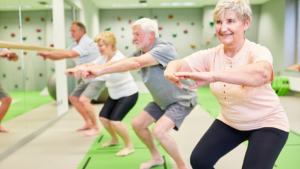In a world where fast food joints litter every corner and work often means sitting at a desk all day, wellness and fitness have become more crucial than ever. They’re not just buzzwords for health fanatics, but essential components of a fulfilling, healthy life.
This article dives into the world of wellness and fitness, exploring their importance and impact on our daily lives. From the benefits of a regular workout routine to the role of nutrition in overall well-being, it’s a comprehensive guide for anyone looking to enhance their lifestyle. So, lace up those sneakers and get ready to embark on a journey towards a healthier, happier you.
Wellness and Fitness

Delving deeper into the elements of wellness and fitness, the article provides definitive explanations of these terms, along with their significance.
Wellness, in its broadest sense, isn’t merely the absence of ailment or disease. It denotes the pursuit of optimal health, creating a balance among the social, physical, spiritual, and mental aspects of an individual’s life. For example, emotional wellness relates to acknowledging and managing feelings and includes self-care, relaxation, stress reduction, and development of inner strength. Similarly, intellectual wellness incorporates stimulating mental activities, expansion of knowledge, and intellectual engagement.
The Connection Between Wellness and Fitness
Exploring the interface of wellness and fitness presents insights into the role of regular physical activity in boosting overall health and well-being. It’s essential to comprehend the symbiotic relationship they hold and their collective contribution to longevity, increased energy levels, and reduced risk of chronic diseases.
Physical Health and Wellness

Physical health and wellness go hand in hand; they intersect at many points, particularly in areas of nutrient absorption, bodily functions, and resistance to diseases. Regular physical activity, the backbone of fitness, amplifies the body’s ability to utilize nutrients, boosting holistic wellness. Aerobic exercise, for instance, significantly improves heart and lung health, thus reducing susceptibility to conditions such as hypertension, heart failure, and coronary artery disease.
The power of physical fitness extends to enhancing the immune system function. Moderate-intensity workouts, like brisk walking or cycling, heighten the body’s resistance to bacterial and viral infections. The cumulative impacts of such fitness-directed activities contribute to robust physical health, forming a firm foundation for overall wellness.
Boosting Mental Health through Fitness
Fitness, often associated with physical wellness, also plays a crucial role in mental health and well-being. Studies reliably show that regular exercise can help ease symptoms of depression, anxiety, and stress. These findings underline fitness as a vital component in the wellness matrix.
For example, engaging in regular cardio exercises, such as running, swimming, or even dancing, triggers the production of endorphins, often referred to as the body’s natural ‘feel-good’ hormones. This not only helps in mood enhancement but also serves as a natural painkiller.
Tips for Incorporating Wellness and Fitness in your Lifestyle

Stepping closer towards wellness and fitness need not be daunting. With actionable steps, assimilating these concepts into daily habits becomes effortless.
Crafting an exercise routine, constant in nature, plays a pivotal role in prioritizing fitness. Start simple, opting for a brisk walk or yoga, gradually escalating to more intensive workouts like strength training or aerobic exercises. Include at least 150 minutes of moderate aerobic activity or 75 minutes of vigorous activity in your weekly routines, as recommended by the Centers for Disease Control and Prevention. Emphasize balance, varying activities to engage different muscle groups, thus preventing monotony and overuse injuries.
In the pursuit of wellness, diet holds equal importance with exercise. Transition smoothly to a balanced diet, focusing on a mix of macro and micronutrients for holistic health. Choose a colorful assortment of fruits and vegetables, lean proteins like fish and skinless chicken, whole grains, and low-fat dairy products, as recommended by the U.S. Department of Agriculture (USDA). Reduce intake of processed foods, especially those high in sodium, sugar, and saturated fat.
Incorporate meal planning and prepping as weekly activities. This not only ensures balanced nutrition but also aids portion control, instrumental in maintaining a healthy weight. One aspect often overlooked involves hydration; drink at least 8 glasses or 2 liters of water daily for optimal body functions.

